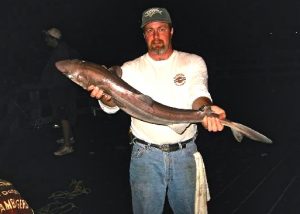
Comments: Oh what a night. Didn’t plan on being out all night but when the fishing is this good you have to take it while you can. I caught a couple 4 footers and 2 that went just over 4 ft with the heaviest weighing in at 13 lbs. on the Boga Grips. Also got to use my new temp gauge; top water temp was 62.4˚F. Was just an all round great night as the guys that were out were great and we laughed our asses off from jokes to catching fish, well Sharks.
Only two bummers, (1) a couple of the guys got cited for drinking on the pier and (2) the second to the last shark I caught (which was a double hookup as I had one on both poles at the same time) bites through one of my net ropes so getting the last one up was tough as we tied the rope back together but the net was then lopsided. Hope you guys going tomorrow night have as much luck as we did. We just “GOT BENT” all night long.
Date: June 19, 2003; To: PFC Message Board; From: handryer; Subject: Ventura Pier — 6/18/2003
In the late ’40’s we called those WSB Tom Cod. Fishing was great off the Ventura Pier in those days. An ‘ol fart.
Posted by Sinker
All right then, you probably remember the old Ventura Pier Bait and Tackle Shop. If so I am looking at getting my hands on one of the old shirts. On the front it said Ventura Bait and Tackle on the pocket and on the back it said Home of the “Fighting Ronkie” and had a picture of a White Croaker doing battle with a fisherman. Do you happen to have one of these shirts? If so can we borrow it to get the design and have more made? Hope to meet you sometime.
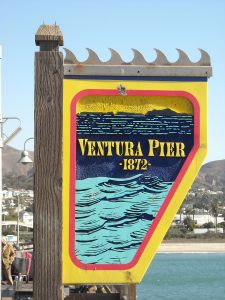
History Note. The May 20, 1871 edition of Ventura’s newspaper, the Ventura Signal, asked “Is it possible that the most flourishing town and region of country on the whole coast is to go still another year without a wharf?” Given the fact that the local roads had axel-breaking potholes during the winter, throat-choaking dust in the summer, and two rivers, the Ventura and Santa Clara, that essentially isolated the city between them during times of rain and flood, it was a good question. With railroads a still distant dream for the future, coastal shipping had to be used for cargo and passengers. And the system of lighters then in use was both inefficient and sometimes dangerous.
That same day, at a town meeting of interested citizens, Joseph Wolfson, owner of one of the small “lighter” barges that carried passengers and freight to and from the ships anchored offshore, along with his father-in-law Juan Camarillo, presented a proposal for the construction of a privately-owned wharf near California Street.
Citizens supported the idea and by March 1872 a $45,000 contract to build the wharf was awarded to R.G. Salisbury, the man who would build many of the wharves in the area. “A wharf at San Buenaventura, so long talked of and so badly needed, is now a fixed fact,” announced the Ventura Signal in its March 2, 1872 edition. “The schooner ‘Free Trade’ arrived here with the first installments of pilings on Monday!”
On May 18, 1872, Arcadia Camarillo Wolfson broke a bottle of wine against the pilings and proclaimed: “In the name of the people of Ventura County, I dedicate (the construction of) this wharf to the uses of commerce and to the promotion of the agricultural and material interests of this section of the state.” Construction soon began on the 1,200-foot-long wharf, a wharf that reached a water depth of 24 feet, and contained railroad tracks out to the end of the pier. On October 5, 1872 the Ventura Signal proclaimed, “It is a grand improvement upon the old way, and duly appreciated by shippers and travelers.” Soon the local farm products—cattle, hogs, sheep, wheat, barley, corn and citrus had a safe method of transport from the wharf, called the Wolfson Wharf by many. By the 1890s oil from west Ventura, Santa Paula and Fillmore had joined the list of exports from the wharf.
In 1874 the wharf was purchased by Captain Robert Sudden, a former sea captain who had helped organize the Pacific Steamboat Company. Just three years later, another newspaper account, dated March 1877, said, “a large portion of the San Buenaventura Wharf was washed away yesterday afternoon.” A second report recorded that “about 300 feet of the old part was washed out… It was so badly bored by teredo that it would have been necessary to rebuild it in a short time.” This was only the first of many such disasters.
On October 23, 1877, it was reported that 400 feet of wharf had washed away at San Buenaventura; “three unusually large breakers approached the pier… and crushed the wharf in pieces like an egg-shell, the pieces going down like straws before a mower…It seems that if the piles had been of good timber and well driven, the wharf would have withstood the surf. The wharf at Hueneme, although equally exposed, passed through the storm all right.” In December of 1878 new damage was reported.
However, Sudden rebuilt after each storm and even improved the wharf by adding a large warehouse for local farmers. His efforts, and later those of this family ensured the continued use by such ships as the S.S. Santa Rosa and S.S. Kalorama and made the wharf a profitable family adventure until 1917.
However it wasn’t always easy. In the early 1900s many of the local coastal vessels were replaced by larger steam ships that only stopped at the larger ports. In addition, a more efficient railroad service began giving the shipping industry its first competition.
In 1914 the wharf again was damaged (cut in half) when the SS Coos Bay was pushed into the wharf by large swells. That damage was repaired by 1917 and an additional section, 500-foot-long, was added making the total length 1,700 feet.
During the first part of the ’20s the pier flourished (it even had its own Sportfishing barge—the Jane L. Stanford). Then, in 1926 history repeated itself when the pier was attacked by storms and suffered considerable damage.
In 1935 much of the wharf was destroyed by fire. Another storm and accompanying large waves damaged over 1,000 feet of the rebuilt wharf in 1937. This time there would be a different response. The wharf was rebuilt back to its prior length and began a new life as a recreational pier (although WW II saw a submarine station located out on at the end of the pier).
Mother Nature wasn’t finished! Storms ravaged the pier in 1949. 1969 saw the end of the pier damaged and in the winter storms of 1977-78 new damage was suffered and part of the pier was closed. Storms hurt the pier in 1983 and then in January of 1986 there was major damage by winter storms and 10-foot waves. Two thirds of the pier was now closed. After partial repairs, the pier was once again opened in 1988 but the outer 500-foot section was closed to anglers.
Agreement was finally reached that a major reconstruction was necessary. Funding was found to carry out the ambitious $3.5 million plan (City of Ventura, California Department of Parks and Recreation, Coastal Conservancy, and the Wildlife Conservation Board) and the work began. Pilings and decking were replaced, fish cleaning stations were added, a snack bar and bait shop was added, restrooms were added, the entrance was widened, and a 5,000 square foot restaurant was built at the shore end of the pier.
On October 2, 1993, the beautiful new, renovated Ventura Pier opened to cannon fire and a flotilla of boats. Soon after, 100 swimmers dived from the pier to swim around and commemorate the pier. The only complaint was from the fishermen who had to wait until late in the day before the crowds cleared and a little serious fishing could begin.
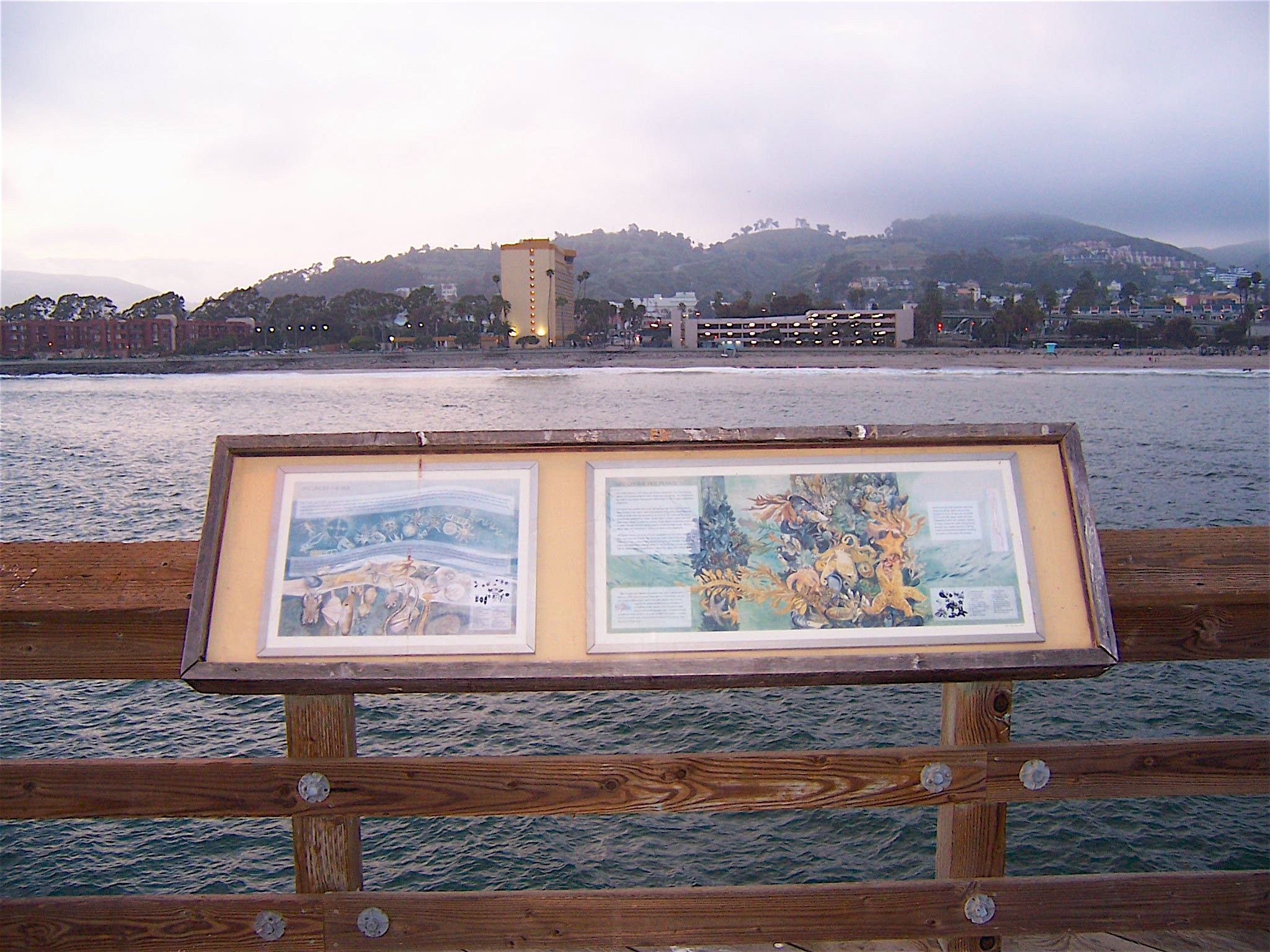
An interesting feature of the pier was a series of interpretive panels, thirty in all, that described local history and ecology. Another interesting item was the “Wavespout,” an $80,000, 6’x6′ copper kinetic sculpture built at the end of the pier; the copper fountain imitated a blowhole and spurted saltwater up to 10 feet high.
Alas, even that major project would not be the last. Storms in December 1994 and January of 1995 necessitated a $500,000 repair and then on December 13, 1995, pounding surf ripped out 420 feet of the pier, including over 150 pilings and the “Wavespout” sculpture. The sculpture washed ashore in two pieces; the pilings were found scattered along the Ventura County coast.
A minimum of $1.5 million, and perhaps as much as $3.3 million, would be required to fix the pier (including placing the sculpture back on the pier). Mayor Jack Tingstrom vowed that the pier would be rebuilt…“it is such a valuable asset to this city…we will just have to find a stronger way to build it.”
The pier eventually had a $2.2 million upgrade, one that included new steel reinforced pilings and a new square deck at the end in; it was finished in 1998. Such is the history of piers at such locations.
What is most impressive to me is the efforts made by local citizens to raise money to restore and maintain their “beloved” pier. In 1993 the community formed a “Pier into the Future” campaign to establish a $1 million endowment fund for the pier. To raise the money, several different fundraisers have been used. In one, individuals, businesses and civic groups can donate various sums of money—$125 Deck Hand, $1,000 First Mate, $2,500 Commander, $5,000 Captain, $10,000 Admiral. In response, they receive a variety of commemorative plaques, “Grant Deeds,” and get their name engraved on an honor roll at the entrance to the pier. A second, highly successful event has been a “Pier under the Stars” food and wine tasting event (which includes a commemorative Pier wine glass). Another has been selling t-shirts, caps and other products, including salsas and barbecue sauces with labels showing the old pier. Last, but certainly not least, has been the issuance of several calendars showing old-time pictures of the pier ($5). It’s a great approach and one that should be copied by many communities. Pier anglers wanting to help Ventura’s campaign can contact these good folks at: Pier Campaign, P.O. Box 99, Ventura, CA 93002-0099, or call them at (805) 658-4739.
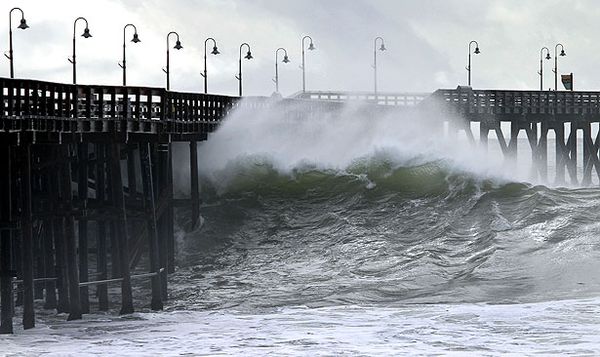
Large waves in 2010
The fundraisers continue and the money is still often needed due to various storms and the damage they inflict. On January 20, 2010, mother nature once again ravaged the coast and inflicted damage on several piers — including Ventura. “Rogue waves” topping 15 feet knocked out a piling and threatened several other resulting in the pier being closed for several days. Sporadic damage continues to be reported over the years.
Today the pier appears to be in good shape and contains an interesting series of displays to help enrich the environment of the pier. One display shows a perpetual tidal movement and describes the forces that affect the tides. Long live this pier and the group that protects and preserves it.
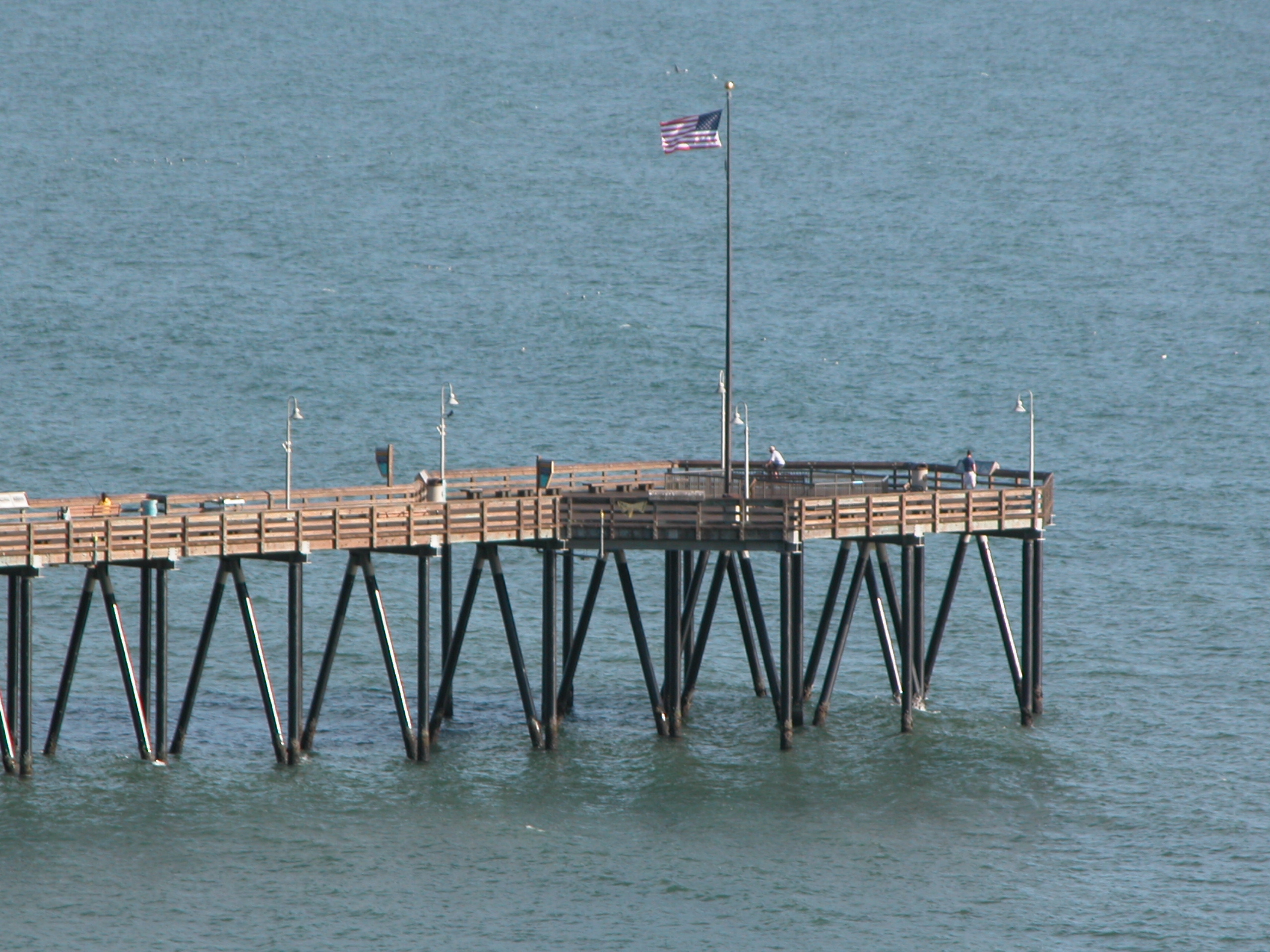
_________________________
Before the coming of the white man and the wharf, the coastline west of the pier was a site from which the native Chumash Indians launched their tomols or plank canoes in pursuit of trade with other coastal and Channel Island villages. One headquarters was the village of Shisholop (meaning in the mud), located in what would be today’s Ventura. The main trade was shell bead “money,” acorns, and fish. The village, established around 1000 A.D. was the site where Spanish explorer Juan Rodriguez Cabrillo first encountered California Native Americans in 1542.
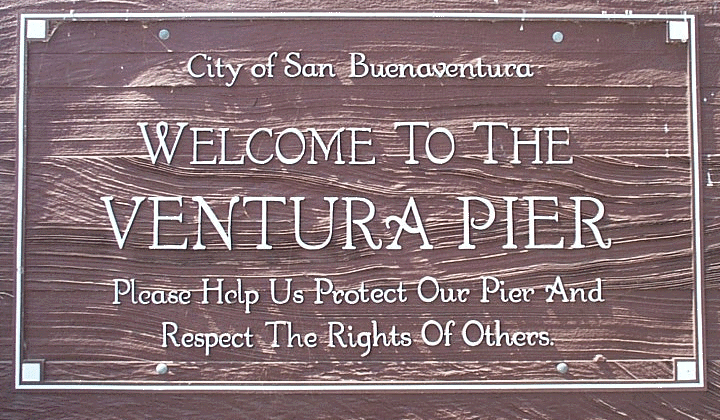
Ventura Pier Facts
Hours: Open 24 hours a day.
Facilities: Lights, benches, fish-cleaning tables, restrooms, bait and tackle, and a snack bar are all found on the pier. A large fish restaurant, Eric Ericsson’s Fish Co., is located at the front of the pier. Near the pier is the parking lot for San Buenaventura State Beach; the cost is $1 an hour not to exceed $5 a day. The parking lot is open 6 A.M. until 11 P.M. but you may leave the parking lot after 11 P.M. since they do not lock the gate. There is very limited free side street free parking but you need to arrive early and be prepared for a considerable walk to the pier.
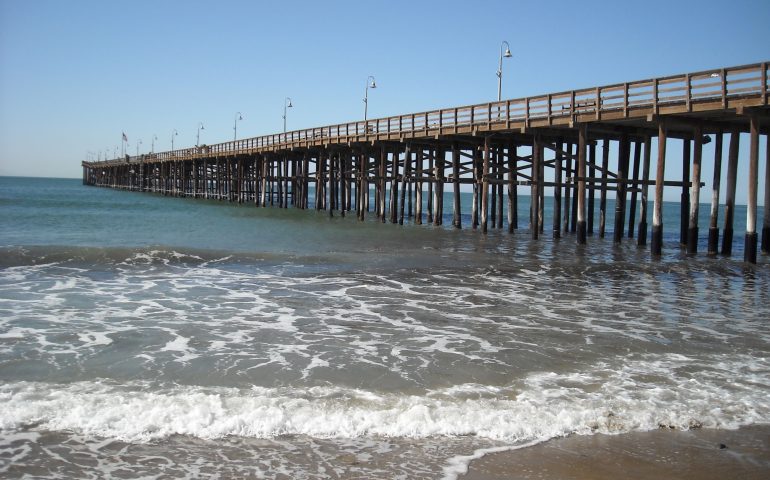
Is there a fish count off of pier? Is its always open?
Handicap access off the main road. Where delivery’ are made. But what about free handicap parking at, to, and for the public pier? I’m bound to a wheelchair. Can i still roll out to the end of the pier comfortably, and without the risk of my wheels becoming stuck risking my chair and me injury buy tipping over? No, because the once present planking that simulated a smooth side walk was removed. The only available FREE HANDICAP PARKING, measures in distance 600+ feet thats equivalent to the length of 2 football fields. And yet look at all that space on the main road to the pier entrance fenced off. True be told, the pier and a wheelchair bounded fishing lover are a very dangerous combonation.
Sorry to hear that Michael. Sounds like things have gone from bad to worse.
I’ve fished the Ventura Pier numerous times several years back, a great pier for sharks, one of the best,and also there are lots of exotic oddball species that frequently show up too, which always keeps things interesting. Fishing the surf area was also usually excellent also, lots of decent size perch and yellowfin croaker as well as quite a few spotfins, which are almost never seen this far north. Overall its a great fishing pier on most days.
I forgot to mention in my last comment that as good as the fishing is on Ventura Pier for Sharks and surf dwelling species its not a very good pier for pelagics (mackerel etc) probably because the water there is usually kind of murky on most days. Its also not a good pier for halibut for some reason. Only saw 1 or 2 short size halibut in all the times I’ve fished there.
Is Ventura pier open for fishing 24 hours?